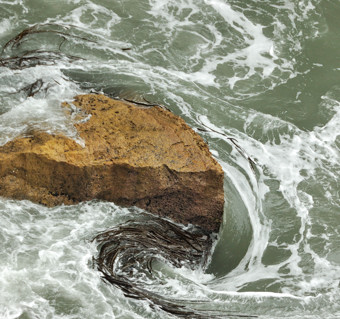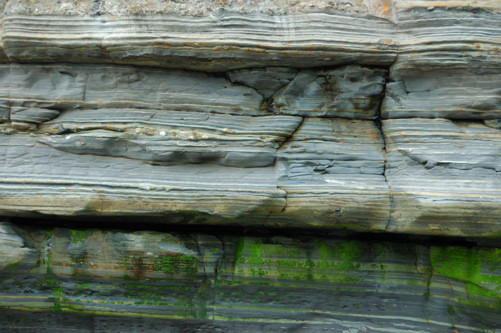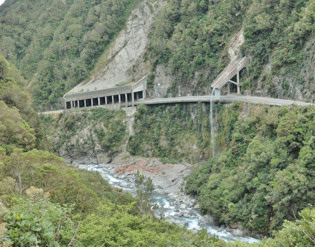 Crossing the continental divide at Arthur’s Pass we drove to Greymouth on the Tasman Sea (the suburb of the Pacific Ocean shared by New Zealand and Australia). The drive across the pass was on a dramatic alpine highway. You can see the one chute that channels a creek over the road and the larger avalanche cover for the road.
Crossing the continental divide at Arthur’s Pass we drove to Greymouth on the Tasman Sea (the suburb of the Pacific Ocean shared by New Zealand and Australia). The drive across the pass was on a dramatic alpine highway. You can see the one chute that channels a creek over the road and the larger avalanche cover for the road.
We have been blessed thus far with mostly sunny days, but today it became gray with drizzle in the afternoon. Nature also failed us in our first excursion of the day, which was to Punakaiki to see the Pancake Rocks about 60 km north of Greymouth.
This rock formation and several other dramatic features on the coast north of Greymouth, is the result of a syncline, a fold in the earth’s crust that has pushed older limestone layers to the surface at the coast. For reasons that are apparently still not clear, near Punakaiki, this limestime has alternating layers that are more or less impervious to the acidic etching of the ground and seawater, causing the layered appearance of the rock in the photo below. Although this may look man-made, it is not.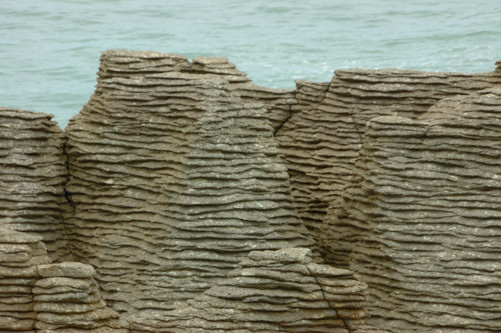 The other thing that draws big crowds to Punakaiki, is the blow holes there. These blow holes are created by a combination of groundwater cutting openings from above and the seawater undercutting the rock formations from below.
The other thing that draws big crowds to Punakaiki, is the blow holes there. These blow holes are created by a combination of groundwater cutting openings from above and the seawater undercutting the rock formations from below. 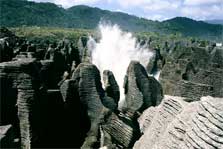 When the tide is high and the surf is up, the waves hitting the base of these formations will shoot up and out of the blow holes (as in the photo to the left that I found on the web) making a loud thumping sound. Unfortunately, although we could arrange to arrive at high tide, we were unable to will a strong swell and so, although we heard a few thumps, we never saw spray out of the top of any of the blow holes.The picture below shows the base of one of the blow holes, being hit by a rather too anemic wave.
When the tide is high and the surf is up, the waves hitting the base of these formations will shoot up and out of the blow holes (as in the photo to the left that I found on the web) making a loud thumping sound. Unfortunately, although we could arrange to arrive at high tide, we were unable to will a strong swell and so, although we heard a few thumps, we never saw spray out of the top of any of the blow holes.The picture below shows the base of one of the blow holes, being hit by a rather too anemic wave. 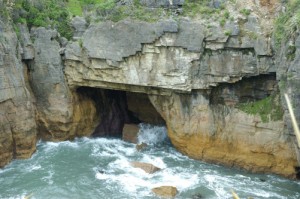
Although the waves were not strong enough to create visible spouts, their action within these rock formations was still impressive. Look at it whipping the kelp in whirlpools in the photo on the left.
Centuries of wave action have also created interesting rock shapes. I would have included one or more of these here, but the rock formations we saw later in the afternoon were so much more dramatic that I’ll show you those instead.
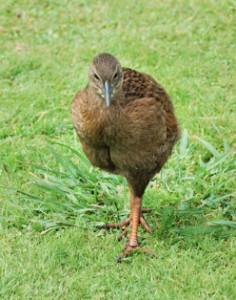 Later, while we were eating lunch, we were visited by a family of wekas. The weka is a flightless bird endemic to New Zealand. About the size of a small chicken they are quick on their feet, bold, inquisitive, and quite interested in everyone’s lunch!
Later, while we were eating lunch, we were visited by a family of wekas. The weka is a flightless bird endemic to New Zealand. About the size of a small chicken they are quick on their feet, bold, inquisitive, and quite interested in everyone’s lunch!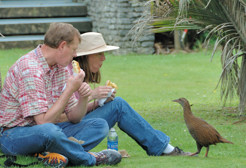
Leaving Punakaiki we drove back south. I found it interesting that in much of what we have seen of New Zealand, where there is reasonably level land along the beach (in many places, the coast is quite steep) it does not appear to be highly valued “beach front property” and often it is agricultural. The picture below, which I’ve included just because I really like it, is looking to the north across one of these fields out over the ocean. The trees are a windbreak; we saw many of these.
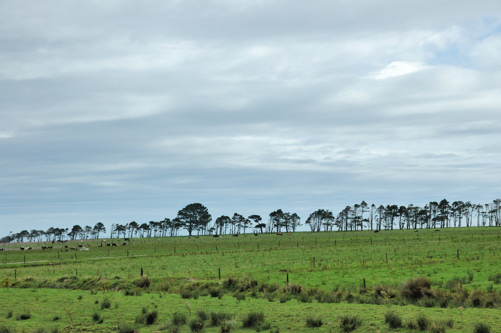
About 40 km south of Pancake Rocks we came to another manifestation of the same rock formation, the Motukiekie Rocks. Without the booming blow holes, this is not a tourist attraction like Pancake Rocks. In fact, although you can see these rocks from the highway, they are no signs to mark them. Fortunately, we had come across an unusual (non-corporate?) guide book, NZ Frenzy, that mentioned this as as a “must see” place and describes how to get access to the beach. You have to look for the place to pull off the road 500 m south of crossing 13 Mile Creek. (Clearly New Zealand has not fully incorporated the metric system.) The photo below shows the main formation.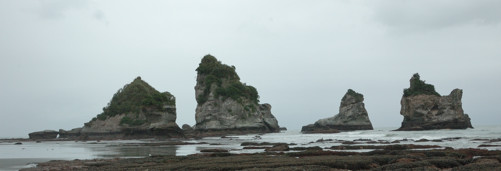
We timed our arrival here to be within two hours of low tide so that we could walk onto the beach. Although there is sand, much of the beach here looks like this.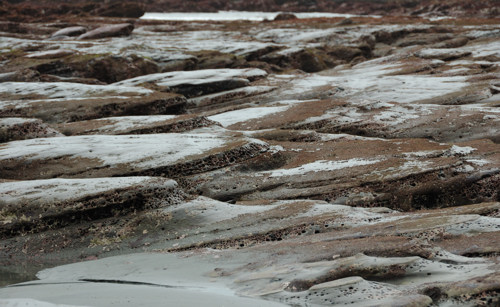 Being able to get up close really lets one better appreciate the majesty of these rocks and the power of the sea action that carved them out.
Being able to get up close really lets one better appreciate the majesty of these rocks and the power of the sea action that carved them out.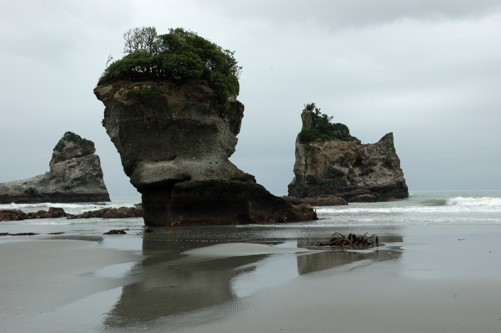
Getting down onto the beach also makes it possible to view the interesting tapestry on the cliffs.
Here is my favorite image from this set — a natural bust.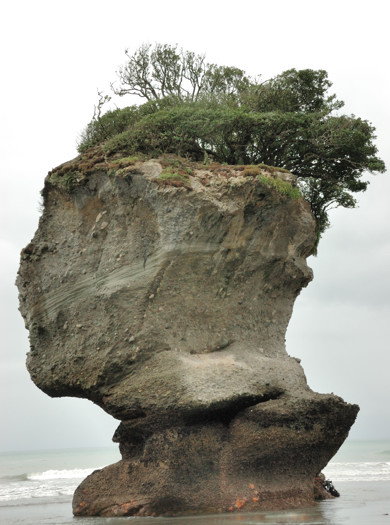
From Motukiekie Beach, we finished a long day of driving by continuing south from Greymouth, in the rain, for about 80 km to a B&B near Hokitika. This is an area known for its jade. After dinner that night we went to see a glow worm grotto. Glow worms are the larval form of an insect that, like fireflies, can emit a soft iridescent light. Unlike fireflies, that use this light as a mating signal, glow worms, which cannot fly, use it to attract flying insects that they capture somehow for food. So being in a glow worm grotto is sort of like looking up to the stars.
